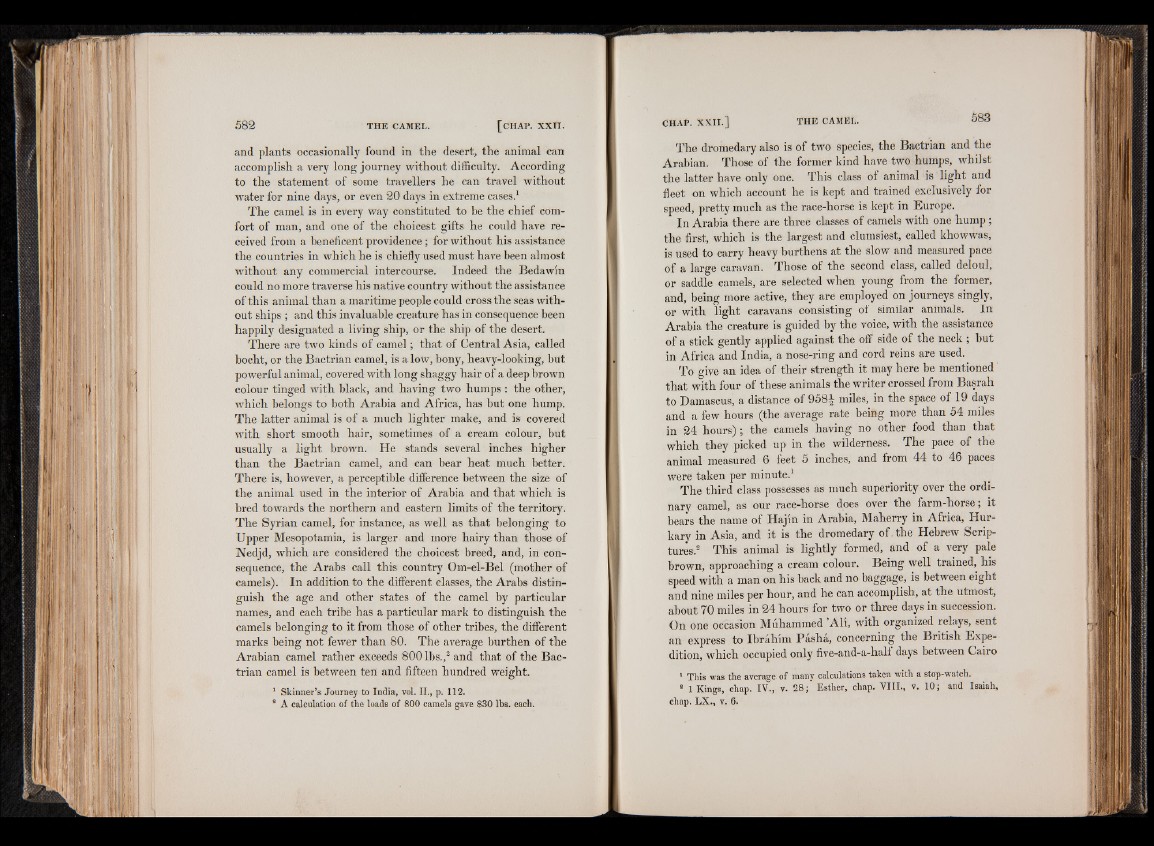
and plants occasionally found in the desert, the animal can
accomplish a very long journey without difficulty. According
to the statement of some travellers he can travel without
water for nine days, or even 20 days in extreme cases.1
The camel is in every way constituted to be the chief comfort
of man, and one of the choicest gifts he could have received
from a beneficent providence; for without his assistance
the countries in which he is chiefly used must have been almost
without any commercial intercourse. Indeed the Bedawin
could no more traverse his native country without the assistance
of this animal than a maritime people could cross the seas without
ships ; and this invaluable creature has in consequence been
happily designated a living ship, or the ship of the desert.
There are two kinds of camel; that of Central Asia, called
bocht, or the Bactrian camel, is a low, bony, heavy-looking, but
powerful animal, covered with long shaggy hair of a deep brown
colour tinged with black, and having two humps : the other,
which belongs to both Arabia and Africa, has but one hump.
The latter animal is of a much lighter make, and is covered
with short smooth hair, sometimes of a cream colour, but
usually a light brown. He stands several inches higher
than the Bactrian camel, and can bear heat much better.
There is, however, a perceptible difference between the size of
the animal used in the interior of Arabia and that which is
bred towards the northern and eastern limits of the territory.
The Syrian camel, for instance, as well as that belonging to
Upper Mesopotamia, is larger and more hairy than those of
Nedjd, which are considered the choicest breed, and, in consequence,
the Arabs call this country Om-el-Bel (mother of
camels). In addition to the different classes, the Arabs distinguish
the age and other states of the camel by particular
names, and each tribe has a particular mark to distinguish the
camels belonging to it from those of other tribes, the different
marks being not fewer than 80. The average burthen of the
Arabian camel rather exceeds 800 lbs.,2 and that of the Bactrian
camel is between ten and fifteen hundred weight.
1 Skinner’s Journey to India, vol. II., p. 112.
! A calculation of the loads of 800 camels gave 830 lbs. each.
The dromedary also is of two species, the Bactrian and the
Arabian. Those of the former kind have two humps, whilst
the latter have only one. This class of animal is light and
fleet on which account he is kept and trained exclusively for
speed, pretty much as the race-horse is kept in Europe.
In Arabia there are three classes of camels with one hump ;
the first, which is the largest and clumsiest, called khowwas,
is used to earry heavy burthens at the slow and measured pace
of a large caravan. Those of the second class, called deloul,
or saddle camels, are selected when young from the former,
and, being more active, they are employed on journeys singly,
or with light caravans consisting of similar animals. In
Arabia the creature is guided by the voice, with the assistance
of a stick gently applied against the off side of the neck ; but
in Africa and India, a nose-ring and cord reins are used.
To give an idea of their strength it may here be mentioned
that with four of these animals the writer crossed from Basrah
to Damascus, a distance of 958J miles, in the space of 19 days
and a few hours (the average rate being more than 54 miles
in 24 hours); the camels having no other food than that
which they picked up in the wilderness. The pace of the
animal measured 6 feet 5 inches, and from 44 to 46 paces
were taken per minute.1
The third class possesses as much superiority over the ordinary
camel, as our race-horse does over the farm-horse; it
bears the name of Hajin in Arabia, Maherry in Africa, Hur-
kary in Asia, and it is the dromedary of . the Hebrew Scriptures.
2 This animal is lightly formed, and of a very pale
brown, approaching a cream colour. Being well trained, his
speed with a man on his back and no baggage, is between eight
and nine miles per hour, and he can accomplish, at the utmost,
about 70 miles in 24 hours for two or three days in succession.
On one occasion Muhammed ’Ali, with organized relays, sent
an express to Ibrahim Pasha, concerning the British Expedition,
which occupied only five-and-a-hall days between Cairo
1 This was the average, of many calculations taken with a stop-watch.
! I Kings, chap. IV., v. 28;" Esther, chap. VIII., v. 10; and Isaiah,
chap. LX., v. 6.